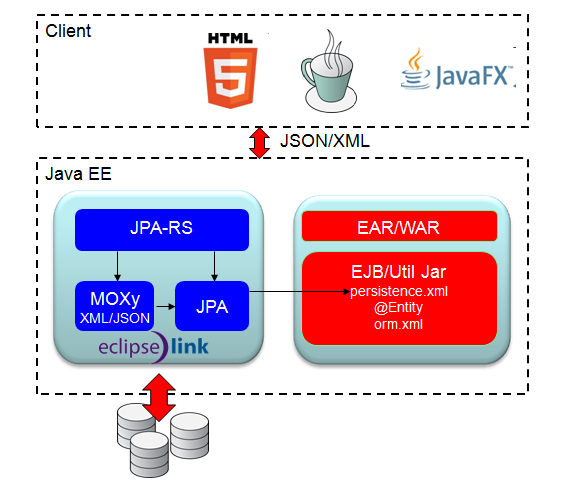Notice: this Wiki will be going read only early in 2024 and edits will no longer be possible. Please see: https://gitlab.eclipse.org/eclipsefdn/helpdesk/-/wikis/Wiki-shutdown-plan for the plan.
Difference between revisions of "EclipseLink/Release/2.4.0/JPA-RS"
(→Security) |
(→Configurable Content) |
||
| (3 intermediate revisions by the same user not shown) | |||
| Line 14: | Line 14: | ||
When enabled JPA-RS will expose the complete capabilities of the persistence units defined within the application. | When enabled JPA-RS will expose the complete capabilities of the persistence units defined within the application. | ||
| − | [[EclipseLink/ | + | [[EclipseLink/Release/2.4.0/JPA-RS/REST-API]] |
=== Persistence Unit Access === | === Persistence Unit Access === | ||
| − | In order | + | In order to use JPA-RS within a web application the JPA-RS library must be included within the WEB-INF/lib folder. JPA-RS contains a web-fragment.xml which at runtime extends the host application's web.xml to expose the JAX-RS end point. |
| − | + | ||
| − | + | ||
| − | + | ||
| − | + | ||
| − | + | ||
== JAX-RS using Jersey == | == JAX-RS using Jersey == | ||
The JAX-RS reference implementation is Jersey ([jersey.java.net]). Additional support will be added to leverage Jersey's (add version) planned support for defining JAX-RS applications and resources using their API. The goal here is to allow JPA-RS to be declaratively configured without requiring any additional code to be included in a user's WAR/EAR. | The JAX-RS reference implementation is Jersey ([jersey.java.net]). Additional support will be added to leverage Jersey's (add version) planned support for defining JAX-RS applications and resources using their API. The goal here is to allow JPA-RS to be declaratively configured without requiring any additional code to be included in a user's WAR/EAR. | ||
| − | |||
== Security == | == Security == | ||
By default all persistence operations and session beans are avaialble for remote access through JPA-RS. In order to restrict access to specific exposed operations standard Java EE security must be enabled. [[EclipseLink/Release/2.4.0/JPA-RS/Security | read more...]] | By default all persistence operations and session beans are avaialble for remote access through JPA-RS. In order to restrict access to specific exposed operations standard Java EE security must be enabled. [[EclipseLink/Release/2.4.0/JPA-RS/Security | read more...]] | ||
| − | |||
| − | |||
| − | |||
| − | |||
| − | |||
| − | |||
| − | |||
| − | |||
Latest revision as of 09:45, 27 June 2012
The EclipseLink 2.4.0 release introduces an easy to use RESTful interface for accessing JPA persistence units and EJB session bean methods using REST calls with XML or JSON media types. With JPA-RS developers can now more easily expose their persistent data model and application logic over REST for the development of Thin Server Architecture (TSA) clients including HTML5/JavaScript and mobile.
Key Features
- Simple Enablement: The JPA-RS capability can be easily added to any Java EE application being deployed to any compliant Java EE server by simply adding JPA-RS components to an application.
- Zero configuration: When enabled the exposed JAX-RS service will allow any persistence unit or related EJB to be accessed using simple REST calls. Optional configuration will be supported for developers who want to limit what capabilities are exposed or wish to customize the resources used in any REST operation.
- Dynamic JPA-RS: Enable the deployment of a generic JPA-RS application into a compliant Java EE server without requiring any included persistence units. This dynamic service will support provisioning of persistence units on the fly by passing in or providing reference to dynamic JPA configuration XML (persistence.xml and eclipselink-orm.xml using virtual entities).
RESTFul API
When enabled JPA-RS will expose the complete capabilities of the persistence units defined within the application.
EclipseLink/Release/2.4.0/JPA-RS/REST-API
Persistence Unit Access
In order to use JPA-RS within a web application the JPA-RS library must be included within the WEB-INF/lib folder. JPA-RS contains a web-fragment.xml which at runtime extends the host application's web.xml to expose the JAX-RS end point.
JAX-RS using Jersey
The JAX-RS reference implementation is Jersey ([jersey.java.net]). Additional support will be added to leverage Jersey's (add version) planned support for defining JAX-RS applications and resources using their API. The goal here is to allow JPA-RS to be declaratively configured without requiring any additional code to be included in a user's WAR/EAR.
Security
By default all persistence operations and session beans are avaialble for remote access through JPA-RS. In order to restrict access to specific exposed operations standard Java EE security must be enabled. read more...

